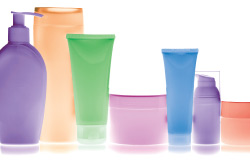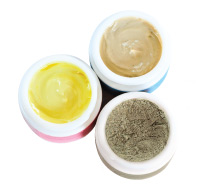The U.S. Food and Drug Administration (FDA) divides skin care products into two distinct categories: pharmaceutical and cosmetic. The aesthetics world divides skin care further yet, into a few more – consumer and professional are just two of them.
First, let us look at how the FDA breaks this down. People often use the term “skin care” to refer to a wide variety of items that we commonly find in the health and beauty departments of drug and department stores. These products may fall into a number of different categories under the law.
Products intended to cleanse or beautify are generally regulated as cosmetics. Some examples are skin moisturizers, perfumes, lipsticks, fingernail polishes, makeup, shampoos, permanent waves, hair colors, toothpastes, and deodorants. These products and their ingredients are not subject to FDA premarket approval, except color additives (other than coal tar hair dyes). Cosmetic companies have a legal responsibility for the safety of their products and ingredients.
Products intended to treat or prevent disease, or affect the structure or function of the body, are drugs. This is true even if a product affects how you look. Some examples are treatments for dandruff or acne, sunscreen products, antiperspirants, and diaper ointments. Generally, drugs must receive premarket approval by the FDA or, if they are nonprescription drugs, conform to special regulations, called monographs, for their category.
Some are both cosmetics and drugs. Examples include anti-dandruff shampoos and antiperspirant deodorants, as well as moisturizers and makeup with sun protection factor (SPF) numbers. They must meet the requirements for both cosmetics and drugs.
Some may belong to other categories. This includes medical devices (such as certain hair removal and microdermabrasion devices), dietary supplements (such as vitamin or mineral tablets or capsules), or other consumer products (such as manicure sets).
The law does not recognize any such category as cosmeceuticals. If a product has drug properties, it must meet the requirements for drugs.1 Many skin care companies that made misleading claims were contacted by the FDA and advised to stop this practice immediately.
According to the FDA’s definition, both consumer products and what we generally refer to as professional products fall under the same category. So what differentiates a consumer product from a professional product in the aesthetic environment? Within the very question lies the answer.
To begin with, let us look at the word differentiate.
dif·fer·en·ti·ate verb (used with object)
1. to form or mark differently from other such things; distinguish
2. to change; alter
3. to make a distinction
4. to perceive the difference in or between
5. to make different by modification, as a biological species
6. to become unlike or dissimilar; change in character
Synonyms: distinguishes, discriminates, discerns, separates, set apart, make a difference, make a distinction, tell between, confuse2
Now, let us define what a consumer skin care product is. In the aesthetics world, we tend to define a consumer product simply by it being available in a retail establishment. Does it make a difference if that establishment is a mass market retailer (Walmart, CVS, Target, Costco) or a prestige retailer (Ulta, Nordstrom, Space UK, Sephora)? What about the direct-to-consumer skin care products and brands (AsSeenOnTV, HSN, QVC)? These distribution channels are all perceived very differently by both the consumer and the professional – largely due to their brand messaging, not necessarily due to their ingredients. There are also the brands that started out, and still do, sell only to licensed skin care professionals, but also take up prime, “eye level buy level” shelf space in your local prestige retailer. By virtue of their existence in treatment rooms, along with their seat on a retail shelf, are they still professionally available for the consumer to snatch up without any expert guidance?
 Mass market brands are produced in very large batches and lack active ingredients, at least at a concentration to actually have an effect on the skin. Most manufacturers add preservatives to ensure long shelf life. Where it would have a therapeutic benefit, many over-the-counter products are not even formulated to penetrate the skin barrier. Furthermore, because many consumers self-diagnose when skin care shopping, these products must have a lower risk of irritation to protect the consumer in the event they are choosing the wrong product for their skin. This is achieved by adding less active ingredients and more filler, thereby lessening results for the buyer. Imagine how confused the average consumer is! Since there is no regulation, when designing packaging and advertising to draw consumers in, many skin care manufacturers’ marketing departments will loosely throw around terms such as “Dermatologist Tested”, “Clinically Proven”, “Clinically Tested”, “Studies show….” There is no actual, legal meaning to those descriptions. Keep in mind that ingredients are listed in content order, from most to least. So if that “active” ingredient is more than five ingredients down the ingredient panel, it is generally a tiny percentage and not enough to support the claims made about the ingredient (not the actual percentage of the ingredient used in the product). And what about product safety? Who is responsible for substantiating the safety of cosmetics? According to the FDA, “Companies and individuals who manufacture or market cosmetics have a legal responsibility to ensure the safety of their products. Neither the law nor FDA regulations require specific tests to demonstrate the safety of individual products or ingredients. The law also does not require cosmetic companies to share their safety information with the FDA.”3
Mass market brands are produced in very large batches and lack active ingredients, at least at a concentration to actually have an effect on the skin. Most manufacturers add preservatives to ensure long shelf life. Where it would have a therapeutic benefit, many over-the-counter products are not even formulated to penetrate the skin barrier. Furthermore, because many consumers self-diagnose when skin care shopping, these products must have a lower risk of irritation to protect the consumer in the event they are choosing the wrong product for their skin. This is achieved by adding less active ingredients and more filler, thereby lessening results for the buyer. Imagine how confused the average consumer is! Since there is no regulation, when designing packaging and advertising to draw consumers in, many skin care manufacturers’ marketing departments will loosely throw around terms such as “Dermatologist Tested”, “Clinically Proven”, “Clinically Tested”, “Studies show….” There is no actual, legal meaning to those descriptions. Keep in mind that ingredients are listed in content order, from most to least. So if that “active” ingredient is more than five ingredients down the ingredient panel, it is generally a tiny percentage and not enough to support the claims made about the ingredient (not the actual percentage of the ingredient used in the product). And what about product safety? Who is responsible for substantiating the safety of cosmetics? According to the FDA, “Companies and individuals who manufacture or market cosmetics have a legal responsibility to ensure the safety of their products. Neither the law nor FDA regulations require specific tests to demonstrate the safety of individual products or ingredients. The law also does not require cosmetic companies to share their safety information with the FDA.”3
Knowing your ingredients and the formulations behind the products is vital to accessing its true efficacy.
Large skin care manufacturers bridge all the distribution channels by offering multiple product lines with varying levels of active ingredients respective to their placement in either mass market, prestige retail or the professional skin care distribution channel. They are all based on the exact same ingredient deck. Add a few bioactives, up the percent of active ingredients, tweak a pH here and there, and we are back to professional products!
During the late 1980s and early 1990s, an innovation in cosmetic chemistry was happening. The introduction of glycolic acid and retinol as miracle ingredients ushered in a new group of products called cosmeceutical, a word coined by Albert M. Kligman, M.D. Although the word cosmeceutical is not categorized by the FDA, it is a word that is used in the professional skin care arena for identifying products that are believed to have a beneficial active biological action on the skin. Dermatological research suggests that the bioactive ingredients used in cosmeceuticals have benefits beyond that of the traditional moisturizer.4 However, despite reports of benefits from some cosmecutical products, there are no legal requirements to prove that these products live up to their claims. Not being a recognized category, cosmecuticals are regulated as a cosmetic. The product formula does not have to be proven effective or safe, only that it contains an ingredient that may have activity on the skin.
 Enter the birth of the professional cosmecutical lines. The select skin care brands tout professional distribution, claiming to only sell into the “professional skin care environment.” Other facilities offering aesthetic services are further defined as aestheticians, spas, destination resorts, and physicians. The true weight of this statement is defined by the adherence to policy by the companies that offer this definition. These products use a high percentage of active ingredients and have supported evidence of superior product formulations. They are wrapped in great packaging and utilize powerful marketing. These brands are backed by scientific data and frequently have a physician founder or spokesperson attached to the brand. This group of cosmetics are considered to be more powerful and desired by both aestheticians and their clients (the consumer).
Enter the birth of the professional cosmecutical lines. The select skin care brands tout professional distribution, claiming to only sell into the “professional skin care environment.” Other facilities offering aesthetic services are further defined as aestheticians, spas, destination resorts, and physicians. The true weight of this statement is defined by the adherence to policy by the companies that offer this definition. These products use a high percentage of active ingredients and have supported evidence of superior product formulations. They are wrapped in great packaging and utilize powerful marketing. These brands are backed by scientific data and frequently have a physician founder or spokesperson attached to the brand. This group of cosmetics are considered to be more powerful and desired by both aestheticians and their clients (the consumer).
Backbar is a component of most professional skin care lines. Many professional companies offer larger sizes of all their homecare products for use in the treatment room. These products lack packaging and product inserts and are economically a better deal for the service provider. Another benefit of having larger sizes of the products your facility is looking to retail is that the client tried them when they received their treatments, making the sale easier. Upfront sampling! This is fine for cleansers and toners, but if you are giving a professional skin care treatment, you want products that the client has to come to you to experience. Enter another level of the professional skin care classification – “Professional Use Only.” This category would be select treatment products, serums, ampules, intense hydrators, acne treatments, enzymes, peels and finishing masks.
Some would argue true professional products are products that do not have a retail counterpart. Others go further, stating that only treatment products that are not allowed to be sold directly to the consumer should be labeled “Professional Use Only.” That category is very small, reserved for acids less than 30 percent with a pH greater than 3. Aestheticians cannot buy this to use either, only medical professionals. The FDA classifies these as drugs. Most of the time you will find an aesthetician using them in the facility, but it is regulated in such a manner that the aesthetician cannot buy them; however, with proper training and supervision, they can use them. Professional is a
big umbrella.
 In conclusion, are there any products that have quantifiable facts that differentiate consumer from professional products? The answer is both yes and no. To a small degree, it is a measurable science of percentages and pH levels that differentiate the available products to the consumer and professional markets. Yet, the consumer can still attain the professional products by acquiring them through an approved retailer or online. How you, as a business owner, choose to differentiate, make a distinction, or distinguish your skin care practice from others is your choice. Your version of professional is one that suits your needs. For some, this is the strength and efficacy of the product. For others, a strong recognized brand; others are focused on organic, green lines or beautiful packaging and celebrity endorsements. Be prepared to do your research when you choosing a skin care line. Knowing your ingredients and the formulations behind the products is vital to accessing its true efficacy. Knowing what is important to you and your clients is what will define you and your business.
In conclusion, are there any products that have quantifiable facts that differentiate consumer from professional products? The answer is both yes and no. To a small degree, it is a measurable science of percentages and pH levels that differentiate the available products to the consumer and professional markets. Yet, the consumer can still attain the professional products by acquiring them through an approved retailer or online. How you, as a business owner, choose to differentiate, make a distinction, or distinguish your skin care practice from others is your choice. Your version of professional is one that suits your needs. For some, this is the strength and efficacy of the product. For others, a strong recognized brand; others are focused on organic, green lines or beautiful packaging and celebrity endorsements. Be prepared to do your research when you choosing a skin care line. Knowing your ingredients and the formulations behind the products is vital to accessing its true efficacy. Knowing what is important to you and your clients is what will define you and your business.
There are as many reasons as there are businesses why one chooses one line over another, but at the end of the day, you have to make the choice that makes the most sense for your business.
Bottom line – there is no official one thing that differentiates consumer from professional lines, therefore, is not the difference what you need it to be?
Resources
1 U.S. Food and Drug Administration. (2013). “Cosmetics Q&A: ‘Personal Care Products’.” http://www.fda.gov/Cosmetics/Resources-ForYou/Consumers/CosmeticsQA/ucm136560.htm
2 differentiate. 2013. Dictionary.com. http://dictionary.reference.com/browse/differentiates?s=t
3 U.S. Food and Drug Administration. (2013). “FDA Authority Over Cosmetics.” http://www.fda.gov/Cosmetics/GuidanceComplianceRegulatoryInformation/ucm074162.htm
4 Elizabeth M. Zettersten, M.D., Ruby Ghadially, M.D., Kenneth R. Feingold, M.D., Debra Crumrine, B.S., and Peter M. Elias, M.D. San Francisco, California. “Optimal ratios of topical stratum corneum lipids improve barrier recovery in chronologically aged skin” (J Am Acad Dermatol 1997;37:403-8.)
 Kimberly Czelusniak is a licensed aesthetician, business development specialist and entrepreneur. A published author, she is a content creator and beauty blogger for many leading skin care brands and aesthetic businesses. After spending 16 years as a B2B sales manager and skin care educator, her focus is now on the beauty industry’s emerging field of social media management and e-commerce sales solutions. Czelusniak is founder and author of the website www.skincareguruforyou.com, an informational website for consumers to get real, honest, expert advice and vital information regarding their skin and lifestyle choices. This email address is being protected from spambots. You need JavaScript enabled to view it.
Kimberly Czelusniak is a licensed aesthetician, business development specialist and entrepreneur. A published author, she is a content creator and beauty blogger for many leading skin care brands and aesthetic businesses. After spending 16 years as a B2B sales manager and skin care educator, her focus is now on the beauty industry’s emerging field of social media management and e-commerce sales solutions. Czelusniak is founder and author of the website www.skincareguruforyou.com, an informational website for consumers to get real, honest, expert advice and vital information regarding their skin and lifestyle choices. This email address is being protected from spambots. You need JavaScript enabled to view it.
Want to read more?
Subscribe to one of our monthly plans to continue reading this article.